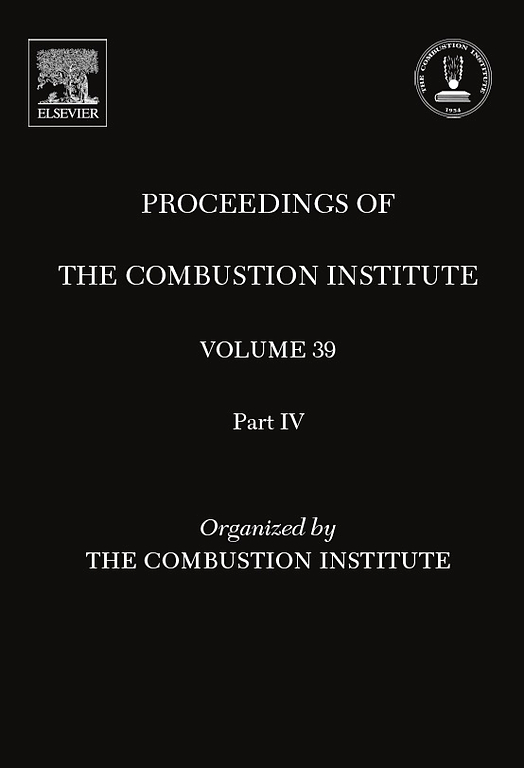Three-stage hybrid NSD/DC plasma assisted n-C5H12/O2/N2 ignition: Improved energy efficiency and reduced NOx/N2O emissions
IF 5.3
2区 工程技术
Q2 ENERGY & FUELS
引用次数: 0
Abstract
This work presents a three-stage hybrid nanosecond discharge (NSD) and direct current (DC) discharge assisted -CH/O/N ignition with lower discharge energy and higher energy efficiency. The reaction rate coefficients between O(aΔ) and -CH are updated by mass/Master equation simulation. The promotive ignition enhancement via reaction channel O(aΔ) + -CH → CH + HO in the hybrid NSD/DC discharge is demonstrated. The results show that the ignition delay time of the three-stage hybrid plasma assisted ignition is 1–2 orders of magnitude shorter than that of the two-stage hybrid discharge when the reduced electric field strength in the DC discharge stage is over 10 Td. Meanwhile, the plasma-enhanced energy efficiency of three-stage hybrid discharge increases. This improved efficiency on ignition enhancement is due to the kinetic enhancement by the electronically excited species and radicals (O(aΔ), O(D), N(B) and O). The kinetic and thermal effects by plasma are effectively intergated to enhance ignition. However, more discharge energy deposited in the vibrationally excited states N() in the two-stage hybrid discharge is less efficient on ignition enhancement due to the thermal contribution via vibrational-translational relaxation. In the aspect of NO/NO emissions, reduction efficiency of the three-stage hybrid discharge is two times higher than that of the two-stage hybrid discharge. By controlling the N/N(D) production pathway e + N → e + N + N(D), the three-stage hybrid discharge reduces NO and NO production by 61.1 % and 90 %, respectively. The results show that the ignition delay time is non-monotonically dependent on the discharge pulse number. There exist optimal pulse number, reduced electric field and effective threshold power density of DC discharge to achieve maximum ignition enhancement and low NO/NO emissions. This study provides valuable insights into the use of NSD/DC hybrid discharge technology in advanced engines to achieve energy-efficient ignition enhancement and reduce NO/NO emissions.三级混合 NSD/DC 等离子体辅助 n-C5H12/O2/N2 点火:提高能效,减少氮氧化物/一氧化二氮排放
本研究提出了一种三级混合纳秒放电(NSD)和直流放电(DC)辅助-CH/O/N点火装置,放电能量更低,能量效率更高。通过质量/主方程模拟更新了 O(aΔ) 和 -CH 之间的反应速率系数。在 NSD/DC 混合放电中,通过反应通道 O(aΔ) + -CH → CH + HO,促进了点火增强。结果表明,当直流放电阶段的降低电场强度超过 10 Td 时,三级混合等离子体辅助点火的点火延迟时间比两级混合放电的点火延迟时间短 1-2 个数量级。同时,三级混合放电的等离子体增强能量效率也有所提高。点火增强效率的提高是由于电子激发物种和自由基(O(aΔ)、O(D)、N(B) 和 O)的动力学增强。等离子体的动效应和热效应有效地结合在一起,增强了点火效果。然而,在两级混合放电中,更多的放电能量沉积在振动激发态 N()中,但由于通过振动-转换弛豫产生的热效应,其点火增强效率较低。在 NO/NO 排放方面,三级混合放电的减排效率是二级混合放电的两倍。通过控制 N/N(D)产生途径 e + N → e + N + N(D),三级混合放电分别减少了 61.1% 和 90% 的 NO 和 NO 生成量。结果表明,点火延迟时间与放电脉冲数呈非单调依赖关系。直流放电存在最佳的脉冲数、减弱的电场和有效的阈值功率密度,以实现最大的点火增强和较低的 NO/NO 排放。这项研究为在先进发动机中使用 NSD/DC 混合放电技术以实现高能效点火增强和减少 NO/NO 排放提供了有价值的见解。
本文章由计算机程序翻译,如有差异,请以英文原文为准。
求助全文
约1分钟内获得全文
求助全文
来源期刊

Proceedings of the Combustion Institute
工程技术-工程:化工
CiteScore
7.00
自引率
0.00%
发文量
420
审稿时长
3.0 months
期刊介绍:
The Proceedings of the Combustion Institute contains forefront contributions in fundamentals and applications of combustion science. For more than 50 years, the Combustion Institute has served as the peak international society for dissemination of scientific and technical research in the combustion field. In addition to author submissions, the Proceedings of the Combustion Institute includes the Institute''s prestigious invited strategic and topical reviews that represent indispensable resources for emergent research in the field. All papers are subjected to rigorous peer review.
Research papers and invited topical reviews; Reaction Kinetics; Soot, PAH, and other large molecules; Diagnostics; Laminar Flames; Turbulent Flames; Heterogeneous Combustion; Spray and Droplet Combustion; Detonations, Explosions & Supersonic Combustion; Fire Research; Stationary Combustion Systems; IC Engine and Gas Turbine Combustion; New Technology Concepts
The electronic version of Proceedings of the Combustion Institute contains supplemental material such as reaction mechanisms, illustrating movies, and other data.
文献相关原料
公司名称
产品信息
阿拉丁
n-C5H12
 求助内容:
求助内容: 应助结果提醒方式:
应助结果提醒方式:


